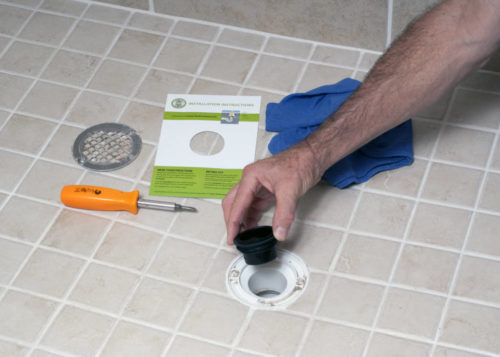Understanding trap-seal protection devices
by Erik Missio | April 10, 2017 10:48 am
 [1]
[1]Photo courtesy RectorSeal Corp.
by Rick Ensley
For decades, the plumbing industry has depended on water-supplied trap primers for maintaining the trap-water levels in floor drains to prevent sewer gas infiltration into occupied spaces. The most common trap primers are connected to a water line and activated via pressure fluctuation from a nearby urinal or water-closet flush that maintains the water levels. Other types divert graywater to the floor-drain trap from nearby sink drains or electronic devices.
Trap primers’ main disadvantage is maintenance. Like many plumbing fixtures, their supply orifices are easily blocked by scale or corrosion. Cleaning or replacing them is an expensive proposition, especially when they require floor and wall demolition/repair for access.
Waterless trap-seal protection devices (TSPDs) circumvent these disadvantages by being virtually maintenance-free barriers. For floor drains, most of these products are push-fit ethylene propylene diene monomer (EPDM) or silicone-based fittings with a one-way membrane that acts similar to a check valve. The membrane’s tight seal prevents sewer gas and insect ingress while also protecting against trap-water evaporation for months. Further, the membrane is sensitive enough to open from the weight of just 118 ml (4 oz) of water draining from a shower stall or floor wash-down.
Building codes are gradually changing across North America to allow these TSPDs in lieu of trap primers. Depending on the jurisdiction, the products can be employed as substitutes in retrofit situations where trap primers have failed. Opening and closing floors or walls to replace trap primers can cost upward of $1000 each, so a product that installs in less than a minute after removing the floor drain grate represents significant maintenance labor savings.
New construction is a different story. TSPDs complying with American Society of Sanitary Engineering (ASSE) 1072, Performance Requirements for Barrier-type Floor-drain Trap-seal Protection Devices, and certified by a third-party test lab, may be substituted for trap primers in new construction and remodeling work, depending on the local jurisdiction and its inspectors. Plumbing consulting engineers that still want trap primers in their specifications might consider combining them with TSPDs. When the trap primer’s life cycle ends, the TSPDs can still offer the facility sewer gas protection.
Forrest Flanagan, CPD, a specifying design engineer at Denver-based engineering and construction management firm, McGrath Inc., specifies them well beyond use as backups to trap primers. Flanagan now specifies TSPDs conforming to ASSE 1072 as substitutes for trap-seal primers on every retrofit and new construction project, dependent on local jurisdictions. (The Colorado Department of Regulatory Agencies’ [DORA] Examining Board of Plumbers made allowances for the practice.)
It is the consulting engineer or contractor’s responsibility to specify a particular brand they deem the best and compliant with ASSE-1072. This author feels it is best to specify a brand, since some manufacturers cannot meet ASSE-1072’s requirements to withstand the effects of dirt, debris, floor wax, and grease-laden waste. Typically, the higher-end, code-compliant models also have a built-in relief valve for eliminating potential air locks between the trap seal and the TSPD that can block floor water draining. There are also some new TSPD models with an added check-valve benefit to protect against property-damaging water backups ranging up to 5 ft of head pressure.
Besides minimizing trap-water evaporation and maintenance, waterless TSPDs can also be considered ‘green’ because they do not require continual filling—this complements water conservation efforts.
Some waterless TSPDs are approved or accepted nationally for all retrofit uses. New construction specification depends on jurisdictions that have adopted ASSE-1072. The following list presents approval levels by state:
- fully approved: Colorado, Connecticut, Illinois, Indiana, Kentucky, Louisiana, Massachusetts, Minnesota, North Carolina, New Jersey, New Mexico, Tennessee, Utah, Wisconsin, and District of Columbia;
- widely approved: Alabama, Arkansas, Arizona, Georgia, Kansas, Missouri, Mississippi, Nevada, New York (except New York City), Pennsylvania, Rhode Island, Texas, and Washington;
- partially approved: Delaware, Oklahoma, South Carolina, and Virginia;
- some approval and currently considering—Alaska, California, Florida, Hawaii, Iowa, Maine, Maryland, Montana, New England, North Dakota, Oregon, South Dakota, Vermont, West Virginia, Wyoming, and Puerto Rico.
Design professionals should always check with the local authority having jurisdiction (AHJ).
 [2]Rick Ensley is the SureSeal product manager at RectorSeal Corp. (Houston, Texas), a manufacturer of barrier-type floor-drain trap-seal protection devices. Ensley is a former plumbing installer who joined SureSeal six years ago. He can be contacted via e-mail at rensley@rectorseal.com[3].
[2]Rick Ensley is the SureSeal product manager at RectorSeal Corp. (Houston, Texas), a manufacturer of barrier-type floor-drain trap-seal protection devices. Ensley is a former plumbing installer who joined SureSeal six years ago. He can be contacted via e-mail at rensley@rectorseal.com[3].
- [Image]: https://www.constructionspecifier.com/wp-content/uploads/2017/04/Dd-Push-Fit-SureSeal-into-Drain.jpg
- [Image]: https://www.constructionspecifier.com/wp-content/uploads/2017/04/Author.jpg
- rensley@rectorseal.com: mailto:rensley@rectorseal.com
Source URL: https://www.constructionspecifier.com/understanding-trap-seal-protection-devices/